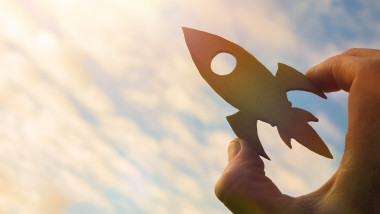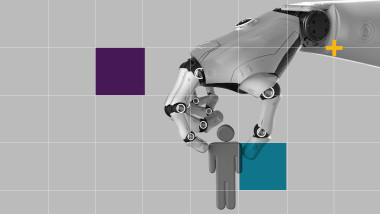Why Everyone's Talking About… The Future of Work

|
|---|

|
|---|
When it comes to how we work, Covid just changed everything. As we continue to adjust to new ways of working, will the future herald a quiet revolution or mass disruption?
In the 1930s, the British economist John Maynard Keynes made a startling prediction: by the time his children had grown up, people might be working just 15 hours a week.1
That didn’t come to pass. Instead, Keynes died of a heart attack in 1946 – allegedly from working too hard – and average annual working hours have barely budged since.2
Sure, the steady rise of white-collar service jobs, the wholesale destruction of unions, and the advent of the internet may have changed the nature of work over time. But nothing near as drastic as Keynes – and others – had foretold.
Then came Covid – and everything changed. Not only are many of us now working from home more often, a trend that is having vast and underappreciated ripple effects across the economy. But the massive increase in AI investment in the past 18 months could one day make Keynes’ prediction a reality – or worse, see millions disappear from the workforce altogether.
All this means the next 50 years of work, and society as a result, will look radically different from today. Yet it’s a revolution that many investors are still overlooking.
“The work from home movement,” says Stanford Economist Nicholas Bloom, “is the biggest impact on urban and labour markets since… World War II.”3
Just how big has the shift been? Pre-pandemic only 5% of total workdays were done at home, a number that was doubling roughly every 12 or 13 years.3 Suddenly, and without warning, that number exploded to around 25%, a fivefold increase, with 45% of workers adopting either a hybrid or totally remote working schedule.3
Or, as Bloom puts it, "We've had roughly 50 years of growth compressed into about two years".
It’s brought with it some immediate boons. Workers are happier overall, saving roughly 70 minutes a day commuting and enjoying a better work-life balance. That, in turn, has boosted productivity, though the overall effect has been somewhat minimal.3
And hybrid or remote work can also be more inclusive, benefitting women and minorities, and may even help boost employee retention.4 Increasingly, forward-looking firms will have to offer hybrid work and greater flexibility in order to attract – and keep – top talent.
Still, this pales in comparison to the geographic impact that ‘working from home’ (WFH) has had. While the long-awaited ‘office apocalypse’ turned out to be a “nothingburger” according to Bloom, the same can’t be said for city retail and residential.
Bloom reckons 6% of retail, mostly situated in large city centres, really has become “Armageddon”, with grim prospects as footfall remains down. E-commerce sales, though falling from the lofty lockdown highs, could be one big beneficiary.3
Meanwhile, WFH has also seen big migrations as workers swap the bright city lights for the serenity of outer suburbs. That’s distorted the residential property market, creating a boom in outer suburbs while city prices have lagged.
That’s not all. The revolution could yet spark long-lasting technological impacts too. An ever-more remote workplace requires huge digital advancements, and corporate America is delivering: the number of patents filed that include words like ‘remote work’, ‘telework’ or ‘work from home’ has more than doubled, from just 1% before the pandemic to over 2.5% now.3
It’s hard to know just what new inventions or breakthroughs may arise as a result – in areas like VR or holograms. But it seems likely we’ll look at 2020 as a game-changing year, with the WFH revolution sparking new technologies and possibilities.
“Now, the rationale has shifted from necessity to opportunity” he adds. “Low up-front costs, rapid scaling, low career-opportunity-costs, greater enjoyment and changing homeownership behaviours are culminating in a paradigm shift in the future of work: a structural rise in multi-earners.“5
The opportunities are endless. Brass TikTokers and high-flying YouTube stars may dominate airtime, but there are opportunities in areas like content creation, selling and reselling, delivery, and extra rents. A pre-pandemic 9-5, Monday-Friday office worker may now only work two or three days a week, supplementing this steady income by renting out his extra bedroom on weekends, sharing saving and investment tips on Instagram or driving an Uber at peak times on busy nights.
This multi-job era is now underscored by a huge and sprawling ecosystem of exciting tech names to invest in too, such as AirBnb, Uber, Shopify, Etsy, Upwork and Fiverr. Some have fared better than others after a torrid 2022, but many have left the wider stock market for dead over time. And the future looks bright.
“While many of the companies in this broad theme are experiencing sharp de-rating pressures, the underlying support for their equity case is powerful from a secular adoption perspective,” Morgan Stanley write.6
It’s a trend employers can’t ignore, either: it’s likely that the multi-earner era will further tighten the labour market as people focus on multiple, part-time income streams that they’re particularly passionate about.
“Not only will the multi-earner economy make it difficult to find [full-time] workers, but it will make it difficult to retain them as workers have more options for income”, says American economist Julian Richers. “Lower barriers to entry to new forms of employment, such as through multi-earn platforms, only strengthens labour’s bargaining power with employers.”7
Unsurprisingly, there’s been an unprecedented investment boom in AI. Total investment, led by the US, finally took off in 2021 (see below) after flatlining for years, and is expected to remain strong going forward.
What does this mean for the future of work? Even more automation, as large firms look to cut costs and improve efficiency wherever possible. That could mean less routine or customer-facing roles, and more talking to chatbots or self-service for the rest of us.
Eventually, this should boost productivity and economic growth – with the possibility of fewer mistakes and higher revenues and margins.
The “deployment of AI and automation technologies can do much to lift the global economy and increase global prosperity, at a time when aging and falling birth rates are acting as a drag on growth,” McKinsey notes. All told, “artificial intelligence (AI) technologies are forecast to add $15.7 trillion to the global economy by 2030,” says PWC.
But there is a dark side: millions of jobs could be lost to AI. McKinsey, for instance, predicts around 15% of the global workforce, or around 400 million workers, will be displaced by automation by 2030, a figure that could rise to 30% - or 800 million – in their worst-case scenario. Yet their slowest scenario sees just 10 million people being displaced, underlying the ongoing uncertainty.
Others, meanwhile, don’t see the rise of AI as a zero-sum game for the workplace. “The question of whether AI will replace human workers assumes that AI and humans have the same qualities and abilities – but, in reality, they don’t,” write Garry Kasparov and David De Cremer. Kasparov, of course, is famous for his shocking defeat to IBM’s Deep Blue at chess in 1997. But just imagine if he’d used AI or Deep Blue to his own advantage.
That could be where we’re headed, they say, with people able to harness AI to unlock new potentials – a synergy dubbed ‘augmented intelligence’. “We believe that greater productivity and the automation of cognitively routine work is a boon, not a threat,” Kasparov and De Cremer add. “After all, new technology always has disruptive effects early on in the implementation and development of new phases and usually reveals its real value only after some time.”
If augmented intelligence pans out as hoped, and that is a big ‘if’, huge productivity gains could soon be unlocked. And supposing such gains are eventually tied to wage growth and working hours, unlike the 1900s, then Keynes’ dreams could finally become reality.
- WFH (Working from home): WFH means an employee is working from their house, apartment, or place of residence, rather than working from the office
- Artificial intelligence: Artificial intelligence is the simulation of human intelligence processes by machines, especially computer systems. Specific applications of AI include expert systems, natural language processing, speech recognition and machine vision.
- Augmented intelligence: Augmented intelligence is a subsection of AI machine learning developed to enhance human intelligence rather than operate independently of or outright replace it.
2 Source : Our World in Data. https://ourworldindata.org/working-hours
3 Source : Real Vision. https://www.realvision.com/shows/real-vision-essential/videos/this-revolution-will-be-peaceful-and-prosperous-xLRz
4 Source: World Economic Forum. https://www.weforum.org/agenda/2022/05/how-hybrid-work-can-drive-diversity-and-productivity/
5 Source: Morgan Stanley. https://www.morganstanley.com/ideas/gig-economy-multi-earner-new-era
6 Source: Morgan Stanley. https://advisor.morganstanley.com/michelle.ward/documents/field/m/mi/michelle-ward/THEMATICS_20220503_0000.pdf
7 Source: Morgan Stanley. https://www.morganstanley.com/ideas/gig-economy-multi-earner-new-era
8 Source: PWC. https://www.pwc.com/us/en/tech-effect/ai-analytics/ai-business-survey.html




 Why Everyone's Talking About… The Metaverse
Why Everyone's Talking About… The Metaverse
 Why Everyone's Talking About… The Energy Transition
Why Everyone's Talking About… The Energy Transition
 Why Investing in Innovation Goes Beyond the Magnificent Seven
Why Investing in Innovation Goes Beyond the Magnificent Seven
 3 Lessons on Artificial Intelligence
3 Lessons on Artificial Intelligence